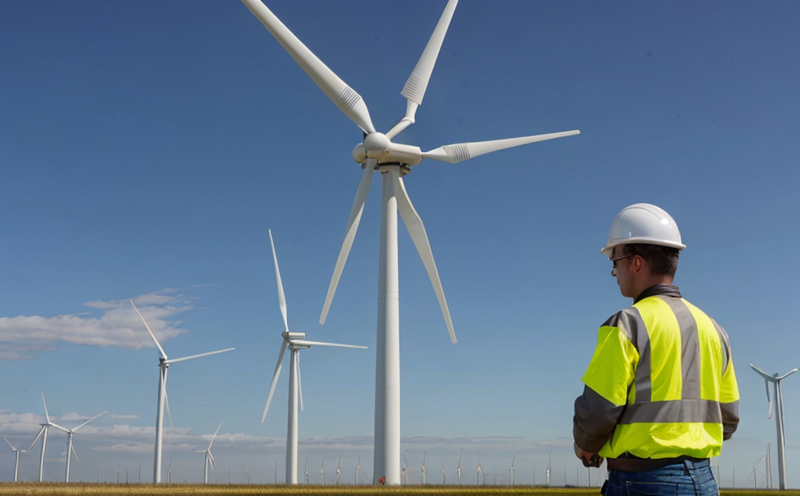Wind turbine electrical system inspection
The inspection of wind turbine electrical systems is a critical process that ensures optimal performance and safety. Wind turbines are complex machines with intricate electrical systems, which play a pivotal role in generating electricity efficiently. These systems consist of various components including generators, transformers, circuit breakers, and cables. Regular inspections help identify potential issues before they escalate into major failures, ensuring the longevity and reliability of wind turbine assets.
Electrical system failures can lead to significant downtime, increased maintenance costs, and even hazardous situations. By conducting thorough inspections, we can prevent these risks by identifying and addressing minor issues early on. The inspection process involves a series of tests that are designed to assess the integrity and functionality of critical components within the electrical systems.
One of the key aspects of this inspection is the testing of insulation resistance. This test measures the ability of the system to resist the flow of current, which is essential for preventing short circuits and other hazardous conditions. Another important aspect is the measurement of ground resistance, ensuring that there are no unsafe voltage differentials between various parts of the turbine.
Additionally, we use advanced diagnostic tools such as thermal imaging cameras and ultrasonic detectors to detect any anomalies in the operation of the electrical systems. These devices help us pinpoint areas where there might be overheating or other signs of wear and tear that could lead to failure if left unchecked. By leveraging these cutting-edge technologies, our inspections provide a comprehensive view of the turbine's health.
The findings from each inspection are meticulously documented in detailed reports tailored specifically for stakeholders involved in wind energy production. These reports include recommendations for corrective actions or preventive measures based on observed conditions during the inspection process. This not only helps maintain compliance with relevant industry standards but also enhances overall operational efficiency by minimizing disruptions caused by unexpected malfunctions.
Our team of highly qualified technicians specializes in this field and adheres strictly to internationally recognized guidelines when performing these inspections. We follow ISO 18463-2:2019, which outlines the requirements for wind turbine inspection and maintenance activities, ensuring that our services meet the highest quality standards.
By investing in regular electrical system inspections, operators can significantly reduce operational risks associated with their renewable energy assets while maximizing output potential. The peace of mind provided by knowing your equipment is functioning correctly allows you to focus on other aspects of your business without worrying about unexpected breakdowns or costly repairs.
Benefits
Conducting regular wind turbine electrical system inspections offers numerous advantages that contribute to the overall efficiency and safety of renewable energy operations. Here are some key benefits:
- Enhanced Reliability: By identifying potential issues early, you can avoid costly repairs or replacements later on.
- Increased Efficiency: Ensuring all components function optimally leads to higher power generation and better performance.
- Safety Improvements: Preventive measures help eliminate hazards that could put personnel at risk.
- Cost Savings: Regular maintenance reduces unexpected downtime and associated expenses.
- Compliance Assurance: Meeting regulatory requirements helps prevent penalties and ensures long-term sustainability.
- Prolonged Asset Life: Early intervention prevents degradation, thereby extending the lifespan of your assets.
In summary, investing in comprehensive electrical system inspections is an essential step towards maintaining optimal performance levels while ensuring safety standards are met. It provides a proactive approach to managing renewable energy assets effectively and efficiently.
Industry Applications
| Industry Sector | Description of Application |
|---|---|
| Renewable Energy | Inspection and maintenance activities for wind turbines to ensure proper functioning. |
| Industrial Manufacturing | Testing and certification processes for electrical components used in industrial machinery. |
| Construction and Engineering | Quality checks on electrical systems installed during infrastructure projects. |
| Aerospace | Verification of compliance with stringent safety regulations regarding aircraft electronics. |
| Automotive | Evaluation of battery management systems and other critical electrical subsystems in electric vehicles. |
The application of wind turbine electrical system inspections extends across multiple industries, including renewable energy where ensuring the integrity of large-scale generators is crucial. In industrial manufacturing settings, these checks help maintain high standards of product quality through rigorous testing protocols. Within construction and engineering contexts, they contribute to safer work environments by verifying that all safety features are operational before new facilities go live. For aerospace companies, compliance with strict international aviation norms demands thorough electrical system evaluations. Lastly, within automotive firms focused on electric mobility solutions, continuous monitoring ensures reliable operation of advanced powertrain technologies.
Use Cases and Application Examples
The following case studies highlight how different organizations have benefited from our wind turbine electrical system inspection services:
- Turbine Operator X: After several unexplained shutdowns, Turbine Operator X engaged us for an inspection. Our team identified a faulty cable connection which was causing the intermittent failures. By replacing this part, they experienced improved uptime and reduced maintenance costs.
- Power Plant Y: Power Plant Y wanted to upgrade its existing turbines without disrupting service. Through our detailed pre-upgrade inspections, we were able to map out necessary adjustments that allowed for smooth integration of new components into the existing setup.
- Energy Company Z: Energy Company Z sought assistance in establishing a robust preventive maintenance program. Our team developed tailored inspection schedules and training programs which enabled their staff to perform effective checks independently, leading to better long-term outcomes.
These examples demonstrate the versatility of our services across various scenarios, from troubleshooting immediate issues to supporting strategic planning initiatives aimed at enhancing operational excellence.





